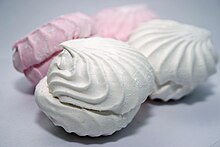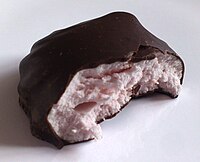 | |||||||
| Alternative names | Zephyr, zephir | ||||||
|---|---|---|---|---|---|---|---|
| Type | Meringue | ||||||
| Course | Confectionery | ||||||
| Serving temperature | Room temperature | ||||||
| Main ingredients | fruit purée, egg whites, sugar | ||||||
| Variations | Food coloring, filling | ||||||
| 329 kcal (1377 kJ) | |||||||
| |||||||
| Glycemic index | 65 (medium) | ||||||
| Similar dishes | Krembo | ||||||
Zefír (Russian: зефи́р, Ukrainian: зефір, Lithuanian: zefyras, may also be spelled zephyr or zephir) is a type of soft confectionery made by whipping fruit and berry purée (mostly apple puree) with sugar and egg whites with subsequent addition of a gelling agent like pectin, carrageenan, agar, or gelatine. [1] It is produced in the countries of the former Soviet Union. [2] The name given after the Greek god of the light west wind Zephyr symbolizes its delicate airy consistency. [3]
History
Zefir is derived from the traditional Russian [4] pastila confectionery, but with added egg white foam and a gelling agent. [5] An addition of unwhipped egg whites to the recipe originated in the town of Kolomna sometime during the 15th century, [6] and in the 19th century the zefir dessert most likely emerged in its modern form with whipped egg whites due to a French adaptation on the recipe that was later brought back to Russia. [7]
Form and consistency
The form typically resembles traditional meringue. [8] However, in contrast to commercial-grade meringue, zefir is never crispy. In contrast to most chocolate-coated marshmallow-like confectioneries; zefirs normally come without layers of cookies/biscuits included.
Zefir is usually milky white, but also comes in rose-colored varieties for flavors containing berries and cherries, or may be colored green if it is flavored with apples. Zefir are also commonly sold with a thin, chocolate outer shell, and on occasion, contain berry-flavored jam on the inside.
Zefir is comparable in its consistency to marshmallows or krembo. [9]
Preparation
Zefir is traditionally made with a purée base, with sugar and egg whites being added before refrigeration. The mixture is subsequently combined with a heated thickening agent (such as agar or pectin), and then whisked (or in modern times, mixed with an electric mixture), until it is of a tacky consistency that can form peaks. It is then piped out of a starred tip and left to dry out. Although the outside will become more firm with a dry consistency, the inside will remain fluffy and sticky. [7]
Gallery
-
A chocolate-coated zefir
-
Clamshell design with mixture of pink and white zefir
-
Zefir (top shelf) on sale at store in Kharkiv
See also
References
- ^ "Zefir – light and healthy national Russian dessert". russia-travel-guide.com. Retrieved 2023-06-02.
- ^ ГОСТ-6441-96, Изделия кондитерские пастильные, общие технические условия (Interstate Standard 6441-96, Pastila type confectionery. General specifications, in Russian)
- ^ Н. М. Шанский; Т. А. Боброва (2004). "Зефир". Школьный этимологический словарь русского языка. Происхождение слов. Москва: Дрофа. (Nikolay Shansky; Tatyana Bobrova (2004). "Zefir". School Etymological Dictionary of Russian Language (in Russian). Moscow: Drofa.)
- ^ Rombeck, Terry (22 Apr 2006). "Ethnic markets put world on a plate for Lawrence residents: Sellers of global cuisine offer international delights". Lawrence Journal-World. pp. 9C. Retrieved 2 Jun 2023.
- ^ В. В. Похлёбкин (2008). "Зефир". Большая энциклопедия кулинарного искусства. Москва: Центрполиграф. ISBN 978-5-9524-3563-6. ( William Pokhlyobkin (2008). "Zefir". Great Encyclopedia of Culinary Arts (in Russian). Moscow: Centrpoligraf.)
- ^ Strange, Nicole Rossetti le (2020-06-22). "Zefir". 196 flavors. Retrieved 2023-06-02.
- ^ a b Drey, Victoria (2017-08-14). "Zephyr: Why is this favorite Russian dessert named after a Greek god?". Russia Beyond. Retrieved 2023-06-02.
- ^ International Food Information Service (2009). IFIS Dictionary of Food Science and Technology (2 ed.). Hoboken: Wiley-Blackwell. p. 462. ISBN 9781405187404.
- ^ Petrosian, Irina; Underwood, David (2006). Armenian Food: Fact, Fiction & Folklore. Bloomington: Yerkir. p. 232. ISBN 9781411698659.


